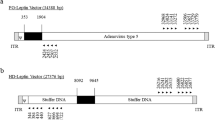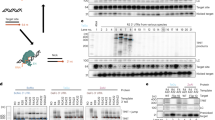Abstract
Recombinant adenoviruses (Ad) are attractive vectors for gene transfer in vitro and in vivo. However, the widely used E1-deleted vectors as well as newer generation vectors contain viral sequences, including transcriptional elements for viral gene expression. These viral regulatory elements can interfere with heterologous promoters used to drive transgene expression and may impair tissue-specific or inducible transgene expression. This study demonstrates that the activity of a metal-inducible promoter is affected by Ad sequences both upstream and downstream of the transgene cassette in both orientations. Interference with expression from the heterologous promoter was particularly strong by viral regulatory elements located within Ad sequences nucleotides 1–341. This region is present in all recombinant Ad vectors, including helper-dependent vectors. An insulator element derived from the chicken γ-globin locus (HS-4) was employed to shield the inducible promoter from viral enhancers as tested after gene transfer with first-generation Ad vectors in vitro and in vivo. Optimal shielding was obtained when the transgene expression cassette was flanked on both sides by HS-4 elements, except for when the HS-4 element was placed in 3′→5′ orientation in front of the promoter. The insulators reduced basal expression to barely detectable levels in the non-induced stage, and allowed for induction factors of approximately 40 and approximately 230 in vitro and in vivo, respectively. Induction ratios from Ad vectors without insulators were approximately 40-fold lower in vitro and approximately 15-fold lower in vivo. This study proves the potential of insulators to improve inducible or tissue-specific gene expression from adenovirus vectors, which is important for studying gene functions as well as for gene therapy approaches. Furthermore, our data show that insulators exert enhancer-blocking effects in episomal DNA.
This is a preview of subscription content, access via your institution
Access options
Subscribe to this journal
Receive 12 print issues and online access
$259.00 per year
only $21.58 per issue
Buy this article
- Purchase on Springer Link
- Instant access to full article PDF
Prices may be subject to local taxes which are calculated during checkout








Similar content being viewed by others
References
Schiedner G et al. Genomic DNA transfer with a high-capacity adenovirus vector results in improved in vivo gene expression and decreased toxicity Nat Genet 1998 18: 180–183
Burcin MM et al. Adenovirus-mediated regulable target gene expression in vivo Proc Natl Acad Sci USA 1999 96: 355–360
Hatfield L, Hearing P . Redundant elements in the adenovirus type 5 inverted terminal repeat promote bidirectional transcription in vitro and are important for virus growth in vivo Virology 1991 184: 265–276
Miralles VJ, Cortes P, Stone N, Reinberg D . The adenovirus inverted terminal repeat functions as an enhancer in a cell-free system J Biol Chem 1989 264: 10763–10772
Leza M, Hearing P . Cellular transcription factors bind to adenovirus early region promoters and to cAMP response elements J Virol 1988 62: 3003–3013
Sassone-Corsi P et al. Far upstream sequences are required for efficient transcription form the adenovirus-2 E1A transcription unit Nucleic Acids Res 1983 11: 8735–8745
Hearing P, Shenk T . The adenovirus type 5 E1A transcriptional control region contains a duplicated enhancer element Cell 1983 33: 695–703
Hearing P, Shenk T . Adenovirus 5 E1A enhancer contains two distinct domains: one is specific for E1A and the other modulates expression of all early units in cis Cell 1986 45: 229–236
Ohyama T . Bent DNA in the human adenovirus type 2 E1A enhancer is an architectural element for transcription stimulation J Biol Chem 1996 271: 27823–27828
Grable M, Hearing P . Cis and trans requirements for the selective packaging of adenovirus type 5 DNA J Virol 1992 66: 723–731
Loeken MR, Brady J . The adenovirus E2a enhancer: analysis of regulatory sequences and changes in binding activity of ATF and E2F following adenovirus infection J Biol Chem 1989 264: 6572–6579
Zajchowski DA, Jalinot P, Kedinger C . E1a-mediated stimulation of the adenovirus E3 promoter involves an enhancer element within the nearby E2a promoter J Virol 1988 62: 1762–1767
Imperiale MJ, Hart RP, Nevins JR . An enhancer-like element in the adenovirus E2 promoter contains sequences essential for uninduced and E1A-induced transcription Proc Natl Acad Sci USA 1985 82: 381–385
Yang Y et al. Cellular immunity to viral antigens limits E1-deleted adenoviruses for gene therapy Proc Natl Acad Sci USA 1994 91: 4407–4411
Lieber A et al. Recombinant adenoviruses with large deletions generated by Cre-mediated excision exhibit different biological properties compared with first-generation vectors in vitro and in vivo J Virol 1996 70: 8944–8960
Spergel JM, Chen-Kiang S . Interleukin 6 enhances a cellular activity that functionally substitutes for E1a protein in transactivation Proc Natl Acad Sci USA 1991 88: 6472–6476
La Thangue NB, Rigby PW . An adenovirus E1a-like transcription factor is regulated during the differentiation of murine embryonal carcinoma cells Cell 1987 49: 507–513
Ptashne M . How eukaryotic transcriptional activators work Nature 1988 335: 683–689
Felsenfeld G et al. Chromatin structure and gene expression Proc Natl Acad Sci USA 1996 93: 93840–93886
Udvardy A . Dividing the empire: boundary chromatin elements delimit the territory of enhancers EMBO J 1999 18: 1–8
Bell AC, Felsenfeld G . Stopped at the border: boundaries and insulators Curr Opin Genet Dev 1999 9: 191–198
Walters MC et al. The chicken beta-globin 5′ HS4 boundary element blocks enhancer-mediated suppression of silencing Mol Cell Biol 1999 19: 3714–3726
Chung JH, Bell AC, Felsenfeld G . Characterization of the chicken beta-globin insulator Proc Natl Acad Sci USA 1997 94: 575–580
Bell AC, West AG, Felsenfeld G . The protein CTCF is required for enhancer blocking activity of vertebrate insulators Cell 1999 98: 387–396
Chung JH, Whiteley M, Felsenfeld G . A 5′ element of the chicken beta-globin domain serves as an insulator in human erythroid cells and protects against position effects in Drosophila Cell 1993 74: 505–514
Emery DW, Yannaki E, Spyridis J, Stamatoyannopoulos G . A chromatin insulator inhibits negative position effects on retrovirus vector expression in vivo American Society of Gene Therapy, 2nd Annual Meeting of the American Society of Gene Therapy 1999 Vol. abstr. No.951: p240a
Rivella S et al. The insulator cHS4 increases the probability that randomly integrated recombinant retroviruses escape transcriptional silencing: implication for gene therapy American Society of Gene Therapy, Washington, DC, 2nd Annual Meeting of the American Society of Gene Therapy 1999 Vol. abstr. No.66: p17a
Palmiter RD . Regulation of metallothionein genes by heavy metals appears to be mediated by a zinc-sensitive inhibitor that interacts with constitutively active transcription factor, MTF-1 Proc Natl Acad Sci USA 1994 91: 1219–1223
Searle PF, Stuart GW, Palmiter RD . Metal regulatory elements of the mouse metallothionein-I gene EXS 1987 52: 407–414
Nelson J, Kay MA . Persistence of recombinant adenovirus in vivo is not dependent on vector replication J Virol 1997 71: 8902–8907
Barr D et al. Strain related variations in adenoviral mediated transgene expression from mouse hepatocytes in vivo: comparison between immunocompetent and immunodeficient inbred strains Gene Therapy 1995 2: 151–156
Vrancken Peeters M-J, Lieber A, Perkins J, Kay MA . Method for multiple portal vein infusions in mice: quantification of adenovirus-mediated hepatic gene transfer BioTechniques 1996 20: 278–285
Shi Q, Wang Y, Worton R . Modulation of the specificity and activity of a cellular promoter in an adenoviral vector Hum Gene Ther 1997 8: 403–410
Friedman JM, Babiss LE, Clayton DF, Darnell JE Jr . Cellular promoter incorporated into adenovirus genome: cell specificity of albumin and immunoglobulin expression Mol Cell Biol 1986 6: 3791–3797
Babiss LE, Friedman JM, Darnell JE Jr . Cellular promoter incorporated into adenovirus genome: effects of viral regulatory elements on transcription rates and cell specificity of albumin and beta-globin promoters Mol Cell Biol 1986 6: 3798–3806
Quantin B, Perricaudet LD, Tajbakhsh S, Mandel J-L . Adenovirus as an expression vector in muscle cells in vivo Proc Natl Acad Sci USA 1992 89: 2581–2584
Imler J-L et al. Targeting cell type-specific gene expression with an adenovirus vector containing the lacZ gene under the control of the CFTR promoter Gene Therapy 1996 3: 49–58
Ring CJA, Harris JD, Hurst HC, Lemoine NR . Suicide gene expression in tumour cells transduced with recombinant adenoviral, retroviral and plasmid vectors containing the ERBB2 promoter Gene Therapy 1996 3: 1094–1103
Smale SR, Baltimore D . The ‘initiator’ as a transcriptional control element Cell 1989 57: 103–113
Hitt MM, Addison CL, Graham FL . Human adenoviral vectors for gene transfer into mammalian cells Adv Pharmacol 1997 40: 137–205
Griscelli F et al. Heart-specific targeting of beta-galactosidase by the ventricle-specific cardiac myosin light chain 2 promoter using adenovirus vectors Hum Gene Therapy 1998 9: 1919–1928
Kay MA, Graham F, Leland F, Woo SL . Therapeutic serum concentrations of human alpha1-antitrypsin after adenoviral-mediated gene transfer into mouse hepatocytes Hepatology 1995 21: 815–819
Kellum R, Schedl P . A group of scs elements function as domain boundaries in an enhancer blocking assay Mol Cell Biol 1992 12: 2424–2431
Workman JL, Taylor ICA, Kingston RE . Activation domains of stably bound Gal4 derivatives alleviate repression of promoters by nucleosomes Cell 1991 64: 533–544
Dunaway M, Hwang JY, Xiong M, Yuen H-L . The activity of the scs and scs′ insulator elements is not dependent on chromosomal context Mol Cell Biol 1997 17: 182–189
Krebs JE, Dunaway M . The scs and scs′ insulator elements impart a cis requirement on enhancer–promoter interactions Mol Cell 1998 1: 301–308
D'ery CV et al. The structure of adenovirus chromatin in infected cells J Gen Virol 1985 66: 2671–2684
Daniell E, Groff DE, Fedor MJ . Adenovirus chromatin structure at different stages of infection Mol Cell Biol 1981 1: 1094–1105
Wong ML, Tsu MT . Psoralen-crosslinking study of the organization of intracellular adenovirus nucleoprotein complexes J Virol 1988 62: 1227–1234
Vassaux G, Hurst HC, Lemoine NR . Insulation of a conditionally expressed transgene in an adenoviral vector Gene Therapy 1999 6: 1192–1197
Kistner A et al. Doxycycline-mediated quantitative and tissue-specific control of gene expression in transgenic mice Proc Natl Acad Sci USA 1996 93: 10933–10938
Wang Y, O'Malley BW Jr, Tsai SY, O'Malley BW . A regulatory system for use in gene transfer Proc Natl Acad Sci USA 1994 91: 8180–8184
Lieber A et al. The role of Kupffer cell activation and viral gene expression in early liver toxicity after infusion of recombinant adenovirus vectors J Virol 1997 71: 8798–8807
Gossen M, Bujard H . Tight control of gene expression in mammalian cells by tetracycline-responsive elements Proc Natl Acad Sci USA 1992 89: 5547–5551
Bett AJ, Krougliak V, Graham FL . DNA sequence of deletions/insertions in early region 3 of Ad5 dl309 Virus Res 1995 39: 75–82
Acknowledgements
We thank Zong-Yi Li and Greg Priestley for technical assistance. We are grateful to Cheryl Carlson, Dmitry Shayakhmetov, and David Russell for critical discussion. We thank David Emery for providing the HS-4 insulator element and Richard Palmiter for the MRE promoter fragment. This work was supported by the Cystic Fibrosis Foundation, and NIH grants R01 CA80192–01, R21 DK55590–01. DS is a recipient of a predoctoral DAAD fellowship.
Author information
Authors and Affiliations
Rights and permissions
About this article
Cite this article
Steinwaerder, D., Lieber, A. Insulation from viral transcriptional regulatory elements improves inducible transgene expression from adenovirus vectors in vitro and in vivo. Gene Ther 7, 556–567 (2000). https://doi.org/10.1038/sj.gt.3301139
Received:
Accepted:
Published:
Issue Date:
DOI: https://doi.org/10.1038/sj.gt.3301139
Keywords
This article is cited by
-
The M4 insulator, the TM2 matrix attachment region, and the double copy of the heavy chain gene contribute to the enhanced accumulation of the PHB-01 antibody in tobacco plants
Transgenic Research (2020)
-
Targeted in vivo knock-in of human alpha-1-antitrypsin cDNA using adenoviral delivery of CRISPR/Cas9
Gene Therapy (2018)
-
Modifications to the INSM1 promoter to preserve specificity and activity for use in adenoviral gene therapy of neuroendocrine carcinomas
Cancer Gene Therapy (2012)
-
Compound screening platform using human induced pluripotent stem cells to identify small molecules that promote chondrogenesis
Protein & Cell (2012)
-
Minimizing the unpredictability of transgene expression in plants: the role of genetic insulators
Plant Cell Reports (2012)



